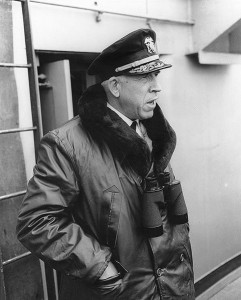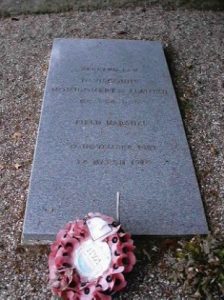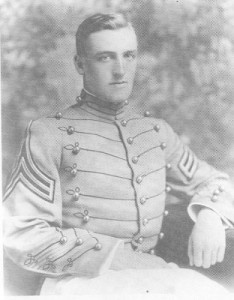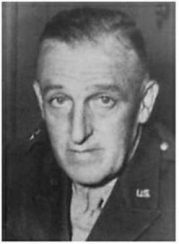Cota, Norman, born on 30-05-1893 in Chelsea, Massachusetts,  the son of George William Cota, a former railroad telegrapher, later a local store merchant, and his wife Jessie H. Mason, a local New England school teacher who came from Croatia. Working at his father’s store in Chelsea, he got the name “Dutch” from his gang friends from Chelsea Square. This nickname would stay with him for the rest of his life. In the fall of 1910, he attended Worcester Academy. In June 1913, he was accepted to the United States Military Academy at West Point.
the son of George William Cota, a former railroad telegrapher, later a local store merchant, and his wife Jessie H. Mason, a local New England school teacher who came from Croatia. Working at his father’s store in Chelsea, he got the name “Dutch” from his gang friends from Chelsea Square. This nickname would stay with him for the rest of his life. In the fall of 1910, he attended Worcester Academy. In June 1913, he was accepted to the United States Military Academy at West Point.  He and the rest of his class graduated two months ahead of schedule in April 1917 because of America’s entry into World War I. Cota, class of 1917 and Dwight “Ike” Eisenhower,
He and the rest of his class graduated two months ahead of schedule in April 1917 because of America’s entry into World War I. Cota, class of 1917 and Dwight “Ike” Eisenhower,


 class of 1915, got to know one another while playing football at West Point. They became and remained good friends. He was assigned to become an instructor at the Academy shortly before the end of the war in 1918, serving there until 1920. At the outbreak of World War II, he was the G-2 Officer, Intelligence and then G-3 Officer, Plans and Training, of the 1st Infantry Division
class of 1915, got to know one another while playing football at West Point. They became and remained good friends. He was assigned to become an instructor at the Academy shortly before the end of the war in 1918, serving there until 1920. At the outbreak of World War II, he was the G-2 Officer, Intelligence and then G-3 Officer, Plans and Training, of the 1st Infantry Division  from March 1941 until June 1942.
from March 1941 until June 1942.

 In June, he was promoted to Chief of Staff of the division, a position he held until February 1943. In February 1943, right after his involvement in the invasion of North Africa, under the command of Major General Terry de la Mesa Allen Sr,
In June, he was promoted to Chief of Staff of the division, a position he held until February 1943. In February 1943, right after his involvement in the invasion of North Africa, under the command of Major General Terry de la Mesa Allen Sr,

 he proposed a report of an assault division on what would become part of Operation Husky, the Allied invasion of of Sicily. He was promoted to the rank of brigadier general and was quickly sent to the United Kingdom, where he served as the United States adviser to the Combined Operations Division of the European Theater of Operations. In that capacity, he helped supervise the training for landing operations. He was the Assistant Division Commander of the 29th Infantry Division, nicknamed “Blue and Gray”
he proposed a report of an assault division on what would become part of Operation Husky, the Allied invasion of of Sicily. He was promoted to the rank of brigadier general and was quickly sent to the United Kingdom, where he served as the United States adviser to the Combined Operations Division of the European Theater of Operations. In that capacity, he helped supervise the training for landing operations. He was the Assistant Division Commander of the 29th Infantry Division, nicknamed “Blue and Gray”  on June 6th 1944, D-Day. Franz Gockel , a German Soldier claimed to have shot hundreds of American soldiers of the 116th Infantry Regiment
on June 6th 1944, D-Day. Franz Gockel , a German Soldier claimed to have shot hundreds of American soldiers of the 116th Infantry Regiment  on Omaha Beach, stationed at his Widerstandnest 62, with his Czech water cooled MG, machine gun, a booty of the Czechian invasion of 1939.
on Omaha Beach, stationed at his Widerstandnest 62, with his Czech water cooled MG, machine gun, a booty of the Czechian invasion of 1939.


A teenage soldier in the Wehrmacht, Gockel had his 18th birthday while serving as a gunner in a ‘resistance nest’ Nr 62, with 726th Grenadier Regiment, on Omaha beach. He was shot in the hand and evacuated to Paris before serving again and being captured by the Americans. After 18 months in custody he was released and returned to his home town of Hamm, where he set up a roofing company and lived a long with his wife. Gockel has made regular trips to Normandy since shortly after the war, and has many friends there.Franz Gockel died age 79, from diabetic, 22-11-2005 in Rhijnern. During World War II, the 29th Infantry Division suffered 3.720 killed in action, 15.403 wounded in action, 462 missing in action, 526 prisoners of war, and 8.665 non-combat casualties, for a total of 28.776 casualties during 242 days of combat. This amounted to over 200 percent of the division’s normal strength. The division, in turn, took 38.912 German prisoners of war. Soldiers of the 29th Infantry Division were awarded five Medals of Honor, 44 Distinguished Service Crosses, one Distinguished Service Medal, 854 Silver Star Medals, 17 Legion of Merit Medals, 24 Soldiers’ Medals, 6.308 Bronze Star Medals, and 176 Air Medals during the conflict. The division itself was awarded four distinguished unit citations and four campaign streamers for the conflict (see Kieffer)

 Despite being personally opposed to the daylight landings,
Despite being personally opposed to the daylight landings,  having lobbied his superiors for a pre-dawn assault, Cota did not allow this to get in his way at Omaha Beach. Cota was not alone in his opposition. General Leonard Townsend Gerow,
having lobbied his superiors for a pre-dawn assault, Cota did not allow this to get in his way at Omaha Beach. Cota was not alone in his opposition. General Leonard Townsend Gerow, 
 commander of V Corps, and Admiral John Leslie Hall Jr
commander of V Corps, and Admiral John Leslie Hall Jr 
 commander of Amphibious Force “O”, the naval force responsible for delivery of the US 1st Infantry Division
commander of Amphibious Force “O”, the naval force responsible for delivery of the US 1st Infantry Division  to the beach, both fought to change the Operation Overlord plan, pleading for a nighttime assault. John Hall died old age 86, on 06-03-1978. The 1st Infantry Division of the United states Army the oldest division in the United States Army. It has seen continuous service since its organization in 1917. It was officially nicknamed the The Big Red One after its shoulder patch and is also nicknamed The Fighting First. However, with typical soldier gallows humor, the division has also received troop monikers of The Big Dead One and The Bloody First as puns on the respective officially-sanctioned nicknames. It is currently based at Fort rilley, Kansas. Casualties during the European campaign, 4.411 killed in action, 7.201 wounded in action, 1.056 missing or died of wounds. One of the highest ranking officers to land on the beaches that day, Cota, working along with one of his regimental commanders, then Colonel, later General, Charles Canham,
to the beach, both fought to change the Operation Overlord plan, pleading for a nighttime assault. John Hall died old age 86, on 06-03-1978. The 1st Infantry Division of the United states Army the oldest division in the United States Army. It has seen continuous service since its organization in 1917. It was officially nicknamed the The Big Red One after its shoulder patch and is also nicknamed The Fighting First. However, with typical soldier gallows humor, the division has also received troop monikers of The Big Dead One and The Bloody First as puns on the respective officially-sanctioned nicknames. It is currently based at Fort rilley, Kansas. Casualties during the European campaign, 4.411 killed in action, 7.201 wounded in action, 1.056 missing or died of wounds. One of the highest ranking officers to land on the beaches that day, Cota, working along with one of his regimental commanders, then Colonel, later General, Charles Canham, 
 personally rallied his pinned-down troops off the beaches and led them inland, telling them, “Gentlemen, we are being killed on the beaches. Let’s go inland and be killed.” While under fire, Cota walked towards troops from the 5th Ranger Battalion
personally rallied his pinned-down troops off the beaches and led them inland, telling them, “Gentlemen, we are being killed on the beaches. Let’s go inland and be killed.” While under fire, Cota walked towards troops from the 5th Ranger Battalion  , yelling “What outfit is this?” Someone replied “5th Rangers!” Cota yelled back, “Well, Goddamn it then, Rangers, lead the way!” This was adopted in part as the Ranger motto, “Rangers lead the way.” Casualties of the Invasion Operations 23 KIA, 89 WIA, and 2 MIA. Total 114 or 22%.
, yelling “What outfit is this?” Someone replied “5th Rangers!” Cota yelled back, “Well, Goddamn it then, Rangers, lead the way!” This was adopted in part as the Ranger motto, “Rangers lead the way.” Casualties of the Invasion Operations 23 KIA, 89 WIA, and 2 MIA. Total 114 or 22%.

 Near the town of St. Lo. General Montgomery
Near the town of St. Lo. General Montgomery 
 visits the Commander of the 29th Division, General Charles Hunter Gerhardt
visits the Commander of the 29th Division, General Charles Hunter Gerhardt 
 and General Omar “Brad” Bradley
and General Omar “Brad” Bradley  presents awards to men for their gallantry in Normandy. As the commander of the 28th Infantry Division, Major General Cota was involved in the Battle of Hurtgen Forest. General Cota’s 28th “Pennsylvania’s Bloody Bucket” Division, sustained heavy losses, just as the German forces.
presents awards to men for their gallantry in Normandy. As the commander of the 28th Infantry Division, Major General Cota was involved in the Battle of Hurtgen Forest. General Cota’s 28th “Pennsylvania’s Bloody Bucket” Division, sustained heavy losses, just as the German forces.
 He and his men did all they could to slow or hold off the direct German assault. He also reviewed and approved the death sentence handed down by a court martial on Eddie Slovik the only U.S. soldier to be executed for desertion since the American Civil War.
He and his men did all they could to slow or hold off the direct German assault. He also reviewed and approved the death sentence handed down by a court martial on Eddie Slovik the only U.S. soldier to be executed for desertion since the American Civil War.
 Cota is said to have approved the sentence because he was appalled by the bluntness of Slovik’s confession. Cota retired from the Army in 1946 at the official rank of Major General.
Cota is said to have approved the sentence because he was appalled by the bluntness of Slovik’s confession. Cota retired from the Army in 1946 at the official rank of Major General.Death and burial ground of Cota, Norman Daniel “Dutch”.



 He died in Wichita, Kansas, on 04-10-1971, at the age of 78 and is buried on the Post Cemetery, Section X, at the United States Military Academy, West Point, New York. Close by the graves of Lieutenant General 82nd Airborne Division,
He died in Wichita, Kansas, on 04-10-1971, at the age of 78 and is buried on the Post Cemetery, Section X, at the United States Military Academy, West Point, New York. Close by the graves of Lieutenant General 82nd Airborne Division,  James “Slim Jim” Gavin, Alexander Patch, General, 7th Army, (see Patch), General, Commander II Corps. Deputy Commander of George Patton, Jeoffrey Keyes. His wife Constance Martha(Connie) Cota (Alexander)
James “Slim Jim” Gavin, Alexander Patch, General, 7th Army, (see Patch), General, Commander II Corps. Deputy Commander of George Patton, Jeoffrey Keyes. His wife Constance Martha(Connie) Cota (Alexander)  died 15-03-1969 (aged 67) in Wichita, Sedgwick County, Kansas, USA Cota’s son Lieutenant Colonel Norman Daniel Cota, Jr,
died 15-03-1969 (aged 67) in Wichita, Sedgwick County, Kansas, USA Cota’s son Lieutenant Colonel Norman Daniel Cota, Jr,
 died 18-03-1988, age (66) in Fort Lauderdale St, Starke, FL, United States (Complacations due to contaminated blood), his daughter Ann Cota-Morris died 31-08-1996 (75),
died 18-03-1988, age (66) in Fort Lauderdale St, Starke, FL, United States (Complacations due to contaminated blood), his daughter Ann Cota-Morris died 31-08-1996 (75),



































Leave a Reply